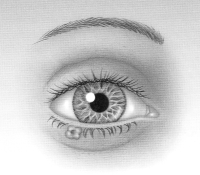Eyelid Skin Cancer & Treatment

Skin cancer commonly involves the eyelid or adjacent face. Eyelid skin cancers most commonly involve the lower lid but can occur anywhere around the eyelid. Common areas include eyelid margins, corners of the eye, eyebrow skin, or adjacent areas of the face. The eyelid margin is especially tricky because the tumor can hide within the lashes for many years.
Eyelid cancers are often called the “Great Masquerader” because they can appear in many different forms or “disguises.” They can appear as painless elevations or nodules sometimes hidden within the lashes. Sometimes the lashes are missing. There can be distortion of the normal skin structure or lid margin. There can be ulcerations, bleeding, and they can be tender to touch. All these lesions need to be evaluated by your eye doctor.
Causes of Skin Cancer
Multiple causes include heredity and toxin exposure, but by far the single most important cause is exposure to the sun. Fair skinned people are most likely to get it because of their relative lack of melanocytes (skin pigment cells) that block the sun from penetrating the skin.
Types of Skin Cancer
By far the most common type of skin cancer is basal cell carcinoma. Second most common is squamous cell carcinoma. Both types are slow growing and fortunately only rarely spread systemically. They will however grow slowly and relentlessly and must be removed completely.
Sebaceous gland carcinoma and malignant melanoma are more serious forms of skin cancer because they can spread through the blood stream. They must be aggressively treated because of the threat of early blood stream spread.
Treatment
Complete removal of the tumor is always the foremost goal. This can be done by a number of methods. One involves removing the tumor and having the pathologist check the margins at the time of surgery “frozen section monitoring” or the next day if the tumor margins seem very clear and the chance of residual tumor is small. Another method, a dermatologic surgeon excises the tumor monitoring the margin through a microscope “Mohs Technique” to ensure total removal.
Once the tumor is completely excised the ophthalmic plastic surgeon goes to work. The operation will be specifically tailored to the defect. The goal is to bring the eyelid back to as normal an appearance and function as possible. Every effort is made to minimize scarring and obtain the most optimal cosmetic result. Healing can take 6 to 12 months. Follow up as recommended by your physician is necessary to detect recurrence of an entirely new cancer.
